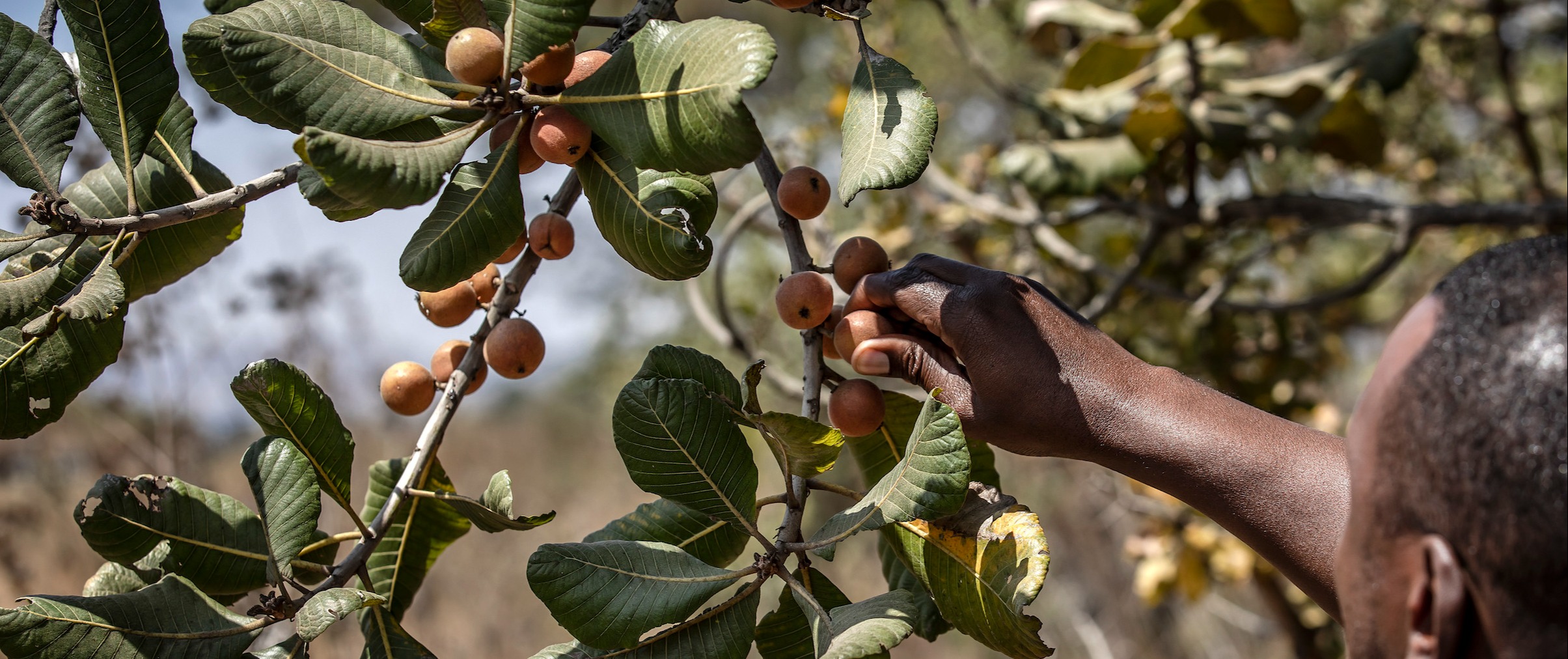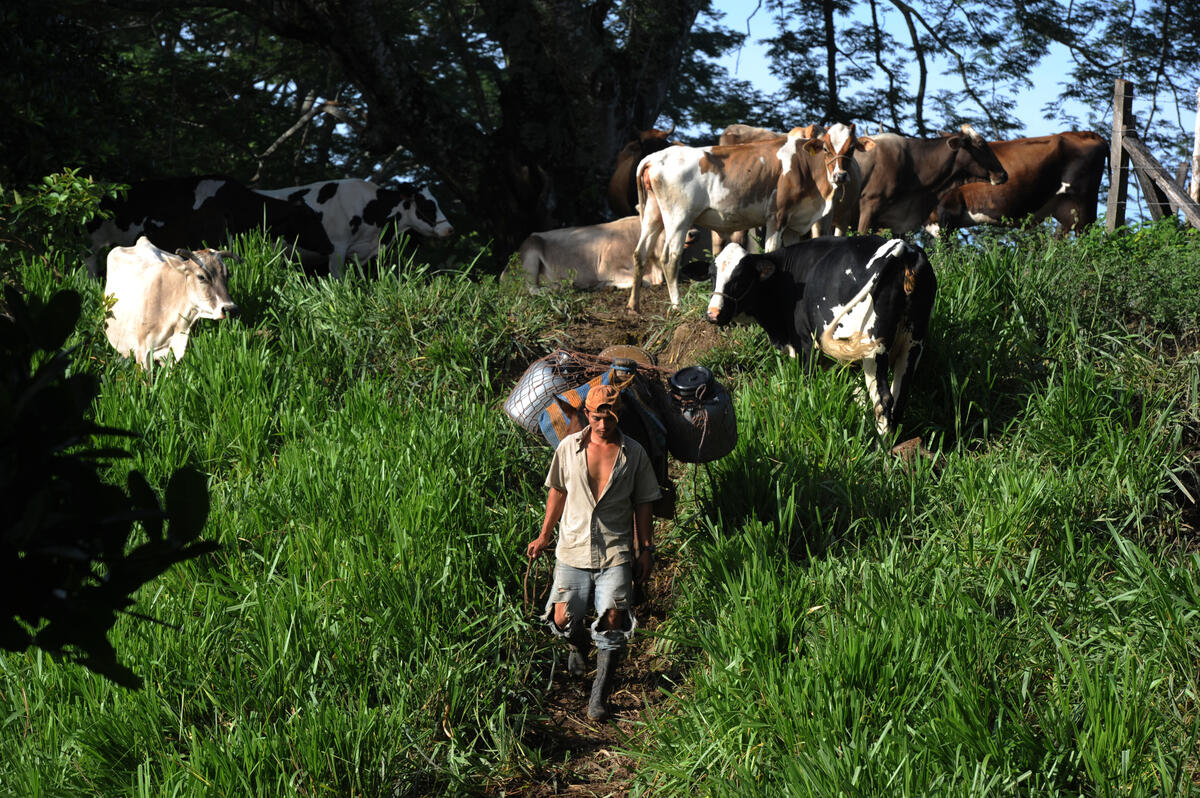Frequently Asked Questions

The intentional integrated planning of agroforestry systems can provide a range of benefits to farmers, the wider community and the environment.
Socioeconomic benefits
- Reduces need for external inputs and increases agricultural productivity
- Enhances and diversifies farm production and farmers' incomes
- Improves access to more nutritious food and improves food security
- Increases resilience to shocks and stresses
Environmental benefits
- Enhances soil health and water management
- Conserves natural resources and enhances farm biodiversity
- Reduces soil and wind erosion and improves microclimates
- Contributes to restoring degraded lands
While agroforestry has been practiced for millennia and has been promoted as a solution in international development agendas since the 1970s, it has struggled to reach widespread success. With renewed attention internationally and a growing body of scientific literature providing evidence of its benefits, transitioning from scientific understanding to successful implementation is an important challenge to overcome.
Many of the barriers are related to insufficient enabling environments for agroforestry, including secure land tenure, supportive policies and incentives, available extension services, and access to markets and value chains. The historical division between agriculture and forestry, and lack of coordination between sectors, has also adversely affected land-use planning and extension services for agroforestry.
Agroforestry has generally been promoted a form of subsistence agriculture, rather than as an economically viable production system. Therefore, there is generally a lack of consideration for labor and resource costs, short-term benefits or linking agroforestry to supply chains, value chains and markets. Additionally, agroforestry research has predominantly focused on biophysical studies at the farm-level, with limited socioeconomic information and a lack of cost-benefit analyses. The limited understanding of investment costs and potential returns also means there has been little innovation in agroforestry.
To find out more about the challenges and obstacles associated with agroforestry uptake and scaling, you can continue reading below and read FAO's paper: Advancing Agroforestry on the Policy Agenda: A Guide for Decision-Makers (FAO 2013).
Risk perception and risk management are some of the main barriers to agroforestry. In general, farmers perceive the longer-term investment of planting trees as riskier or even unfeasible in comparison to annual crops. On average, agroforestry sees profitable returns after 3-8 years, while annual cropping systems normally see profits within 1-2 years.
Agroforestry requires multidisciplinary knowledge and skills in trees, crops, and/or animals. Lack of comprehensive extension services and guidance on how trees, crops, and livestock interact with each other can make the transition to agroforestry more complex for farmers.
The environmental benefits of agroforestry, such as soil and water conservation and increased resilience, are important but are not necessarily primary decision-making factors for farmers. They may consider high transaction costs associated with changing production methods and longer-term returns on investments more important.
It is important to acknowledge that agroforestry has had a mixed record of success and needs to be promoted in a way that recognizes both its potential and its limitations. Agroforestry also has transaction costs, such as higher labor requirements, delayed return on investments, or potentially reduced production in the short-term.
Providing technical support to overcome challenges and to improve the sustainable adoption and scaling-up of agroforestry is a foundation for FAO Forestry's work on agroforestry.
Agrisilvicultural systems
| Improved fallows | Woody species planted and left to grow during fallow |
| Taungya | Combined stand of woody and agricultural species during early stages of establishment of plantations |
| Alley cropping (hedgerow intercropping) | Woody species in hedges; agricultural species in alleys in between hedges; microzonal or strip arrangement |
| Multi-layer tree gardens | Multi-species, multi-layer dense plant associations with no organized planting arrangements |
| Multi-purpose trees on crop lands | Trees scattered haphazardly or according to some systematic patterns on bunds, terraces or plot/field boundaries |
Plantation crop combinations | Such as integrated multi-storey mixtures of plantation crops; plantation crops in alternate; shade trees for plantation crops; shade trees scattered; intercropping |
| Home gardens | Multi-storey combinations of various trees and crops around homesteads |
| Trees in soil conservation and reclamation | Trees for bunds, terraces, raisers, etc. with or without grass strips; trees for soil reclamation |
| Shelterbelts and windbreaks, live hedges | Trees around farmland/plots |
| Fuelwood production | Interplanting firewood species on or around agricultural land |
Silvopastoral systems
| Trees on rangeland or pastures | Trees scattered irregularly or arranged according to some systematic pattern |
| Protein banks | Production of protein-rich tree fodder on farm/rangelands for cut-and-carry fodder production |
| Plantation crops with pastures and animals | For example, cattle under coconuts in Southeast Asia and the South Pacific |
Agrosilvopastoral systems
| Home-gardens involving animals | Multi-storey combinations of various trees, crops and animals around homesteads |
| Multi-purpose woody hedgerows | Woody hedges for browse, mulch, green manure, soil conservation, etc. |
Other systems
| Apiculture with trees | Trees for honey production |
| Aquaforestry | Trees lining fish ponds, tree leaves being used as "forage" for fish |
There are no accurate or current figures for the global extent of agroforestry. As agroforestry encompasses a multitude of land management practices, it is difficult to estimate its extent. One of the most cited global estimates suggests that 43% of all agricultural land features agroforestry, representing over 1 billion hectares of land and more than 900 million people (Zomer et al. 2016). This is estimation defines agroforestry as a minimum of 10% tree cover on agricultural lands. Based on this definition, agroforestry is particularly prevalent in Southeast Asia, Central America, and South America, where over 50% of agricultural land has at least 10% tree cover.
While trees on agricultural land is one proxy, it excludes agroforestry systems that are found in forest land or rangelands and overestimates the amount of agroforestry in agriculture as not all farms with trees are agroforestry systems.
Given its multidimensional nature and the diverse range of agroforestry systems, defining, monitoring and estimating the extent of agroforestry is no easy task. Yet monitoring and improving data are necessary to understand the status and progression of agroforestry, as well as to improve decisions on where agroforestry could be expanded.
FAO's Global Forest Resources Assessments (FRA), measure agroforestry under its "Other land with tree cover" category. For almost 20 years, FAO has raised awareness of the importance of trees outside forests (TOF), including agroforestry, and has worked towards supporting larger-scale assessments of TOF, including a thematic study on TOF as part of FRA 2010.
Recent improvements in remote sensing and higher resolution satellite imagery warrant renewed large-scale agroforestry assessments. FAO is leading a global study on monitoring agroforestry extent to improve data and establish a global baseline of agroforestry.
Agroforestry systems are land management practices that intentionally integrate trees, crops, and/or animals. Whereas agroecology encompasses the transformation of agrifood systems to be equitable and in harmony with nature.
Agroecology is concurrently a science, a set of practices and a social movement. Over recent decades, it has evolved as a concept to expand from a focus on fields and farms to include the entirety of agriculture and agrifood systems. It seeks to optimize the interactions between plants, animals, humans and the environment while also addressing the need for socially equitable food systems. There is no single way to apply agroecological approaches- it depends on local contexts, constraints and opportunities, but there are common principles that have been articulated in the framework of the 10 Elements of Agroecology.
Agroforestry can be considered as one of the main families of agroecological practices and exemplifies many of the 10 Elements of agroecology. For example, the inherent composition of agroforestry systems which includes a combination of trees with crops and/or animals is a prime example of the Diversity Element of agroecology. However, not all agroforestry follows agroecological principles; this depends on how an agroforestry system is designed and managed. Applying the elements of agroecology to agroforestry requires intentional planning and active management.
Agroforestry systems that successfully integrate agroecology can improve short, medium and long-term outcomes for farmers, maximize the potential ecological benefits of agroforestry, and are generally more sustainable.
FAO aims to strengthen the linkages between agroforestry and agroecology in its work by emphasizing systems interactions and helping farmers better manage trade-offs in the transition towards agroecology and agroforestry.
To find out more about agroecology please visit the Agroecology Knowledge Hub.
Agroforestry can be considered a strategy for both climate change mitigation and adaptation. Integrating trees in agricultural systems can help to reduce the impact of climate change on agriculture, and, inversely, decrease agriculture's contribution to the global phenomenon. Here are some examples of the ways in which agroforestry can contribute to both climate change mitigation and adaptation.
Mitigation
- Trees planted and grown in agroforestry systems contribute carbon sequestration. In a global analysis, remote sensing data estimated that tree cover contributed at least 75 percent of the 45.3 GtC on agricultural lands in 2010 (SOFO 2022).
- Sourcing wood products from on-farm production decreases the need to cut trees, thus reducing the rate of deforestation, which is one of the main factors contributing to climate change.
- Better management of soil nutrients reduces the need to resort to fertilizers, another significant source of GHG emissions.
Adaptation
- Agroforestry systems are diverse and are thus more resilient than conventional agricultural systems to environmental shocks and the effects of climate change, such as severe storms, droughts and floods, due largely to the diversity of benefits they provide.
- They increase food security and nutrition by serving as safety nets during such shocks, especially when these affect entire communities rather than single households.
- By providing shade and a cooler environment to sensitive crops or animals, agroforestry can help maintain or increase yields in the face of climate change, strengthening agriculture’s resilience.
- The water conservation functions of trees and forests help prevent or fight desertification and its social and environmental consequences.
- Agroforestry improves soil health and can restore degraded lands, thereby supporting longer-term sustainable land use.


